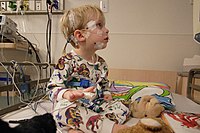
Photo from wikipedia
I read with great interest the review paper by Gottlieb et al. [1]. bi-directional association among RLS, PLMS and CVD should be The authors summarized the association of restless legs… Click to show full abstract
I read with great interest the review paper by Gottlieb et al. [1]. bi-directional association among RLS, PLMS and CVD should be The authors summarized the association of restless legs syndrome (RLS) with cardiovascular disease (CVD) and also considered the mechanisms of cardiovascular morbidity with other sleep disorders, such as obstructive sleep apnea (OSA) and periodic limb movements in sleep (PLMS). I have some concerns about their review with special reference to the combination effect of RLS and PLMS on CVD. First, PLMS are frequently found in patients with RLS [2]; information on the combined risk for CVD has not been elucidated. Woo et al. surveyed the prevalence of post-stroke RLS and PLMS by a limited number of samples [3]. Among six patients with either post-stroke RLS or post-stroke PLMS, two patients had both conditions. By observing differences in the clinical and radiological features of post-stroke RLS and post-stroke PLMS, they concluded that two conditions had different pathophysiological findings. In contrast, Gottlieb et al. speculated that PLMS related to sleep fragmentation and elevation of blood pressure [4,5]. Although Walters and Rye reviewed the relationship of RLS and PLMS to hypertension, heart disease, and stroke, they failed to confirm the mechanism of the association [6]. Fulda reported the hypothesis on the role of PLMS in patients with RLS with special reference to cortical arousals and cardiovascular risk [7]; risk assessment of PLMS linking RLS for CVD should be continued by further studies. Second, Koo et al. investigated an association between RLS and depression with special reference to sleep disturbance, PLMS, and antidepressant medication [8]. Depression was significantly associated with moderate-to-severe RLS. Further, the RLS-depression relationship is modestly explained by sleep disturbance and PLMS. Taken together, depression and antidepressant medication should be included for risk assessment on CVD. Finally, Buratti et al. evaluated the prevalence and the lesion topography of new-onset RLS/PLMS in 66 patients with lacunar stroke [9]. PLMS were detected in 56% of stroke patients, whereas RLS alone or in association with PLM was present in 23% of stroke patients. The biological mechanism of the effect of lacunar stroke on the incident of RLS/PLMS should be confirmed by a large prospective study. Furthermore, plausible mechanism of
Journal Title: Sleep medicine
Year Published: 2017
Link to full text (if available)
Share on Social Media: Sign Up to like & get
recommendations!